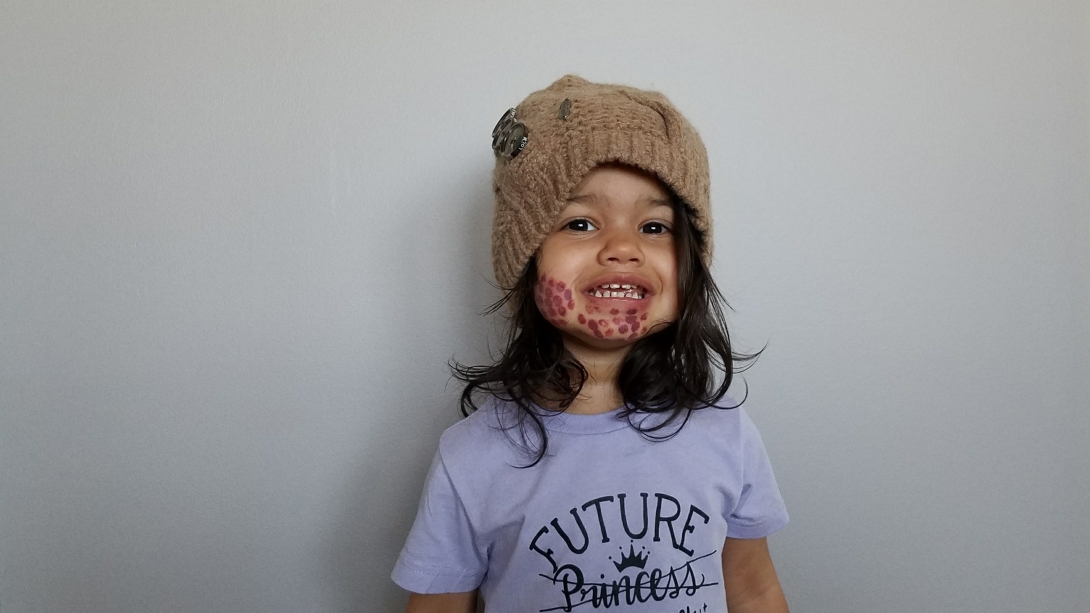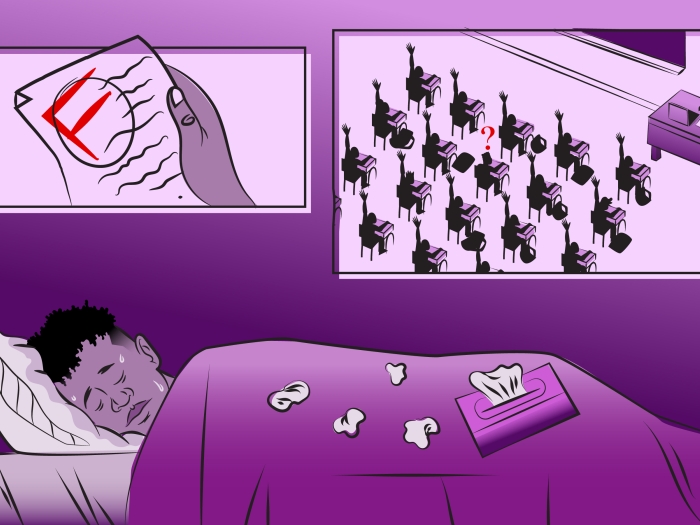An unpreventable birthmark, many port wine stains can be managed with laser treatment. How one family is doing so — and educating others in the process.
7:00 AM
Author |

This article was updated on May 6, 2021.
When Meghana Lee was born in March 2015, doctors performed a cesarean section because the baby was lodged on her mother's hip.
MORE FROM MICHIGAN: Sign up for our weekly newsletter
They first thought the reddish spots on the baby's cheek, chin and right ear were a result of the delivery — some bruising, perhaps, from her atypical position in the womb.
Still, "Hours went by, days went by, and it [the markings] never went away," says Meghana's mother, Jody, who with her husband, John, struggled to process a lack of answers from their care team. "I didn't know who to ask. I didn't know what to ask."
A visit to a pediatric dermatologist several months later brought an instant conclusion: port wine stains.
Such vascular birthmarks, true to their name, look as if the maroon liquid was spilled on one's skin. The condition affects about 1 in 3,000 live births, affecting males and females and all racial groups equally.
Although the markings are almost always present from birth — the unpreventable result of a genetic change or defect — there isn't a specific test to confirm them.
"It's primarily a clinical diagnosis," says Jeffrey Orringer, M.D., a professor and service chief in the department of dermatology at the University of Michigan Medical School. "We look for a pattern of hypervascularity, or extra blood vessels, in the skin."
Formally called a capillary vascular malformation, a port wine stain is characterized by a localized area of excess capillaries, Orringer says.
The area and scope of the stains varies by individual. In rare cases, port wine stains may be linked to a rare disorder known as Sturge-Weber syndrome.
For most children, though, the stains are unrelated to other medical conditions. They are permanent, and tend to darken over time. An excessively rich blood supply can lead the affected tissue to thicken and, in turn, develop a cobblestone-like texture. Bleeding, infection and a decreased quality of life may follow.
Though the stains will grow in proportion as a child ages, they won't otherwise spread.
In addition, the impact of such a distinct birthmark on a child's face can also complicate social adjustment during critical times in a child's growth.
Reactive measures
Early action, especially within a child's first year of life, is key to reducing the presence of a port wine stain, says Orringer.
Since two years-old, Meghana has visited the University of Michigan's C.S. Mott Children's Hospital about every six to eight weeks for therapeutic sessions with a device known as a pulsed-dye laser.
SEE ALSO: Thanks to Hit TV Show, One Boy's Rare Disease Not So 'Strange'
The goal: to help the body heal itself.
"The laser emits light of a wavelength that is preferentially absorbed by the color of blood," says Orringer, who has seen and treated Meghana since she was 6 months old. "The heat that is transferred from the target [skin] to the wall of these excessive blood vessels causes the body to reabsorb the vessels."
The regimen, Orringer notes, shows results in about 80% of patients.
The procedure lasts just a few minutes — with a person's eyes covered with gauze for protection. Many children receive sedation to help them stay relaxed and ensure safety during the procedure, which requires the child remain still.
While the laser's pulsations could be likened to feeling a repeated snapping of a rubber band on the skin, the visual aftereffects often far eclipse the temporary discomfort for patients.
Says Orringer: "They're not in great pain, but they look like they've been through a brawl because they have bruises on their skin."
Bruises disappear several days later. And Meghana's parents say they've watched the port wine stains fade noticeably.
Her treatments likely will continue indefinitely, though the frequency will taper off over time.

'It's just a part of who she is'
The Lees, residents of Orion Township, Michigan, don't want their daughter's appearance to define her.
But they want to educate more people about port wine stains.
Jody, after all, often bristles when having to explain to other adults that her daughter's laser treatments are to ensure health and well-being — not vanity.
"People need to stop using the word 'cosmetic,'" she says. "This is about her health."
Which is why in August they staged the first annual Purple Polka Dot Race, a charitable 5K that raised $14,000 for the Vascular Birthmarks Foundation.
"It was such a special day," says Jody, who works as a physical therapist. "We just kind of looked at each other to say, 'Hey, we're normal.'"
The Lees know they will need to explain the particulars of port wine stains to their child as she grows older.
One way they already have approached the subject: a custom-made teddy bear named "B.B." (short for "Birthmark Bear") whose facial spots mirror those of his young owner. They've also read the children's books "Sam's Birthmark" and "Buddy Booby's Birthmark" together.
Her parents connect with other families via Facebook for extra support.
They're grateful for a child who is otherwise no different from her peers — a "sassy" and active toddler who enjoys swimming and spending time with her grandfather.
"She has such a big heart," says Jody. "She loves everybody, everything."
As for the birthmarks, "it's just a part of who she is."
Four years later
Meghana, now six years-old, remains very active – dancing, swimming, doing gymnastics, playing piano, going to school and playing with her younger sister, Serena.
She is still receiving laser treatments from Orringer, though the frequency has decreased. Over the past year and a half her treatments have been cut down to two or three times a year.
"Once the vascular lesion has improved, we tend to transition to periodic maintenance which can vary from two or three times per year for some to once every few years for others, depending on how the lesion progresses," Orringer says.

The treatment device has also evolved with each generation of pulsed dye laser providing increased safety and efficacy for patients.
"Recently, a new generation pulsed dye laser, called the VBeam Prima, was produced," says Orringer. "The device allows us to treat our patients more rapidly and, in some cases, with higher fluence levels (energy) to maximize the response after each treatment session. We are pleased to be able to offer this state-of-the-art technology to our patients."
Continued education
As Meghana has grown, her parents continue to educate Meghana on the specifics of why she receives laser treatments.
Meghana often questions why her younger sister or her friends don't need laser treatments like her.
"We don't sugar coat it – it's a vascular birthmark and there's a medical component to it. Lasers keep her skin healthy and help prevent complications which tend to occur later in life," says Jody. "It's important to understand the reason for it and be as factual as possible."
"Any capillaries that remain after the initial treatment series naturally and gradually expand and this is the reason why additional treatment sessions are necessary over time," adds Orringer. "All of this is intended to prevent thickening of the affected skin and the formation of vascular papules, or "bumps", that can be fragile and bleed easily later in life."
Support
Meghana still has her teddy bear, B.B., who continues to join her at laser treatments. And a new book, Made Marvelous, helps reinforce that we all have differences and shows how to handle these with grace and kindness.
But the network of others in the birthmark community has been the most impactful in her ability to handle the challenges her laser treatments can present.
Last June, Meghana had a laser treatment scheduled right before a birthday party and she was nervous about having the purple polka dots afterward. However, she was able to get four of her friends from the birthmark community on the phone and talk through the situation. They supported her and she felt more confident going to the party.
"As a mom without a birthmark, there is only so much I can do," says Jody. "I can tell her she's beautiful a thousand times over, but it means so much more coming from someone that can truly relate."
Meghana has a network of adults who also have port wine stains she is able to call on when needed. She can see they live normal lives and these relationships have been really special to her.
The Lee family continues to do their part to create awareness around and educate the community about vascular birthmarks.
The Purple Polka Dot Race is now in its sixth year and, since its inception, has raised almost $80,000 for the Vascular Birthmarks Foundation.
For every $500 raised, one scholarship is awarded to a family to attend the foundation's annual conference. This is particularly personal for the Lee family because they, too, were recipients of such a scholarship and the conference is what led them to Orringer. The money raised from their race now is their way of giving back to the community.
Reflections
Jody thinks back to the nights she stayed up late on her computer trying to figure out what to do, what was next and what life would be like for her daughter.
The Lee family has since become great advocates for the vascular birthmark community and has a message for anyone starting their journey:
"Take a deep breath and know it will be okay," says Jody. "There is a solid group of people behind you and we're all here for you. Search for the VBF, search for the Michigan Port Wine Stains Facebook group, search for the Purple Polka Dot Race – our community is awesome and we'll welcome you with open arms."
According to Orringer, Jody has been a wonderful source of information and a great source of comfort for other families with children who have port wine stains. Her positive and proactive approach has contributed greatly to Meghana's wellbeing.
"It has been an absolute joy watching Meghana grow into a bright, happy, and very mature little girl," adds Orringer.

Explore a variety of healthcare news & stories by visiting the Health Lab home page for more articles.

Department of Communication at Michigan Medicine
Want top health & research news weekly? Sign up for Health Lab’s newsletters today!





